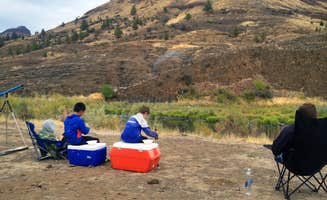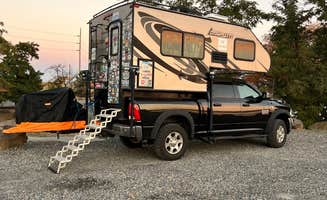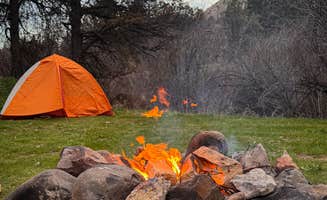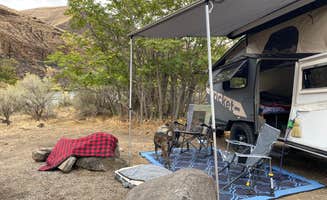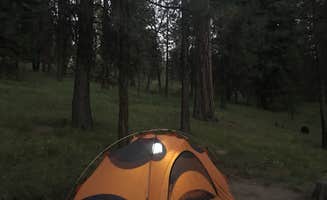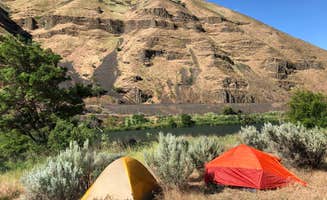Dispersed camping opportunities surround Fossil, Oregon in the high desert region of central Oregon, with elevations ranging from 1,200 to 4,500 feet throughout camping areas. Summer temperatures often reach 90-100°F during the day but drop 30-40 degrees at night. The area features a mix of BLM and Forest Service land with varying access requirements and seasonal road conditions that can limit travel during winter months or after heavy rainfall.
What to do
Fishing access points: Several campsites near Fossil provide excellent fishing opportunities on the John Day River. At Macks Canyon Recreation Site, campers note the fishing focus: "Minimal people, desert, fishing. We went during weather transition from rain to clear. The result, high winds in the canyon."
Historic railway hiking: From certain camping areas, you can access abandoned railway trails with canyon views. Near the Lower Deschutes area, a reviewer shared: "From the end of the Lower Deschutes Access Road just above the campground, you can hike along the old railway line. Again, amazing views of the Deschutes and the canyon."
Night sky viewing: The remote location offers exceptional stargazing with minimal light pollution. At Burnt Ranch Road/Bridge Creek near the Painted Hills, campers report "Fantastic star gazing and nice quiet spot after the day traffic along the main road visiting the park have left."
What campers like
Proximity to Painted Hills: Tent camping near Fossil, Oregon provides convenient base camps for exploring the John Day Fossil Beds National Monument. A camper at Bridge Creek noted: "Great location! Really nice spots and some campfire rings as well."
River swimming spots: The John Day and Deschutes Rivers offer cooling relief during hot summer days. At Service Creek Campground, a visitor found: "Large parking lot on the John Day, not exactly on it. It was SO hot but we had to head east to beat the smoke. We found several walk in tent spots, nothing for Van's, trailers. The river invited us down...beautiful swimming space."
Scenic isolation: Many campsites offer true solitude with minimal neighbors. In the Ochoco National Forest, a reviewer appreciated: "There are trails in abundance and beautiful views to be had, in addition to lakes, mine remnants and vistas galore. Camp, trail run or just bbq at the lake."
What you should know
Wind conditions: Many camping areas experience strong evening winds that require secure tent staking. At Priest Hole Recreation Area, a camper observed: "The campground itself is clean and well appointed."
Water availability: No drinking water exists at most camping areas near Fossil, requiring campers to bring sufficient supplies. At Muleshoe Campground, reviewers note: "The campground is very basic. The toilets were clean. Great place for staying the night before a river trip."
Road conditions: Access to more remote sites requires navigating rough roads. One camper reported about Macks Canyon: "About 20 miles of gravel road will take you here and some small Rockwall to semi-worry about. Other than that most people you'll bump into are fisherman or overlanding."
Fire restrictions: Seasonal fire bans are common throughout summer months. A Lower Deschutes camper explained: "Very dry area covered in dry wheat and dry brush so most of the Spring/Summer/Fall campfires are not allowed. This was the first time in years I camped without a fire."
Tips for camping with families
Swimming locations: Find camps with gentle river access for cooling off. At Service Creek, a visitor shared: "After cooling down and finding a spot under a tree, we decided to stay. So quiet and magical as the evening wore on."
Train watching: Camps near rail lines provide entertainment for children. At Hike in from Lower Deschutes State Rec Area, a camper mentioned: "A train will pass by at least a couple times over the course of a night, but it's kind of a fun sight as long as it doesn't come by in the middle of the night."
Wildlife viewing opportunities: Various camps offer chances to see deer, birds, and small mammals. In the Ochoco Forest, "There is something for everyone here."
Shade considerations: Limited tree cover means planning for sun protection. At Bridge Creek, a camper advised: "Lots of space and very easily accessible but make sure to fuel up before you go it's a bit of a drive."
Tips from RVers
Pull-through options: Some sites offer easier access for trailers. At Muleshoe Campground, a camper found: "There are six campsites with space for vehicles and four walk-in sites. Chose a pull through site and were the only people in the entire campground."
Length restrictions: Many riverside camping areas have limited turning radius. At Priest Hole, one RVer noted: "The road to the river sites is NARROW, and we had trouble backing in with a 22' trailer while not hitting the guard rail, but the pull through sites are a lot farther from the river."
Road clearance issues: Access roads often require higher clearance vehicles. A reviewer at Bridge Creek mentioned: "Easy to miss as there are no signs and it is an abrupt turn off. Had the whole place to ourselves for one night."


